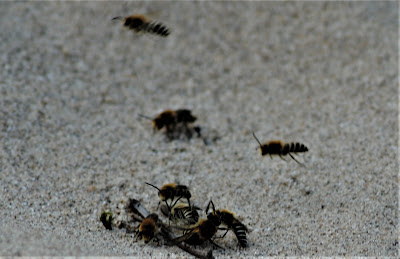This blog may help people explore some of the 'hidden' issues involved in certain media treatments of environmental and scientific issues. Using personal digital images, it's also intended to emphasise seasonal (and other) changes in natural history of the Swansea (South Wales) area. The material should help participants in field-based modules and people generally interested in the natural world. The views are wholly those of the author.
Sunday, 20 September 2020
Seeing the Changes 1494
Also some critters on the walk through Crawley woods to the beach. Small copper butterflies (Lycaena philaeus); Eristalis arbustorum; and Drone fly (Eristalis tenax). There was much activity by bees burrowing in the dunes. The bee itself (Dasypoda altercator) is shown competing in a group and alone. A collection of tunnels is also shown in the side of a dune. Other Hymenoptera were evident in a digger wasp (Ammophila sabulosa) and Marble galls of Andricus kolleri. On the beach itself was a Brittle star (Ophiothrix fragilis).
Subscribe to:
Post Comments (Atom)
-
I n the UK and US, a pparently popular and successful vegan/vegetarian restaurants are reportedly closing or adding meat to their menus ( ...
-
Early ripening fruit may seem convenient but some folk think it confirms environmental stress. There's also a possibility th...










%20mating%20NWCW.jpg)


No comments:
Post a Comment